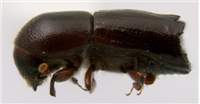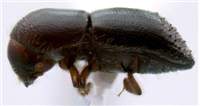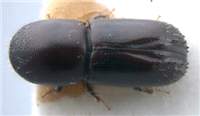Diagnosis
Black, densely punctured. Antennal club very broad. Pronotum tight around head. Protibiae slightly inflated on posterior side. Elytral margins slightly curved, but no mycangium apparent. First and second interstriae divergent, broadest on elytral summit.
Distribution
Palaeotropical.
Biology
Mostly unknown.
Taxonomy
Described by Hulcr & Cognato (2010).
Detailed description
Eyes deeply emarginate, sometimes almost disjunct, upper part smaller than lower part. Antennal club appears broader than tall, sometimes much broader, club type two (obliquely truncated, segment 2 visible on posterior side), or three (with segment 1 straight or convex). Segment 1 of club straight (may be slightly concave or convex) on anterior face, margin of segment 1 clearly costate all around antenna. Segment 2 corneous on anterior side, visible or not on posterior side. Segment 3 minor, absent from or only partly visible on posterior side. Segment 1 of antennal funicle shorter than funicle. Frons distinctly convex, heavily punctured. Submentum deeply impressed, shaped as very narrow triangle. Anterior edge of pronotum with no conspicuous row of serrations (serrations no different than on pronotal slope). Pronotum from lateral view elongated with low summit (type 7), from dorsal view elongated basic shape with rounded frontal margin (type 7). Pronotal disc densely and evenly punctured, lateral edge of pronotum obliquely costate. Procoxae contiguous, prosternal posterocoxal process conical and slightly inflated. Tuft on pronotal basis associated with mesonotal mycangium absent, setae on elytral bases associated with elytral mycangium absent. Scutellum small, appears embedded in between elytra. Elytral bases sinuate, with curved margin, even though elytral mycangia absent. Elytral disc longer than declivity, flat, with large strial punctures, shining interstriae. Declivity flat, separated from disc either by simple oblique boundary, or surrounded by large elevated sulcus with large teeth. Elytral declivity with few setae or scales, not conspicuously pubescent. Posterolateral declivital costa ending in 7th interstriae, or reaching encircling most or all of declivity. Tuberculation of declivity variable, from inner part of declivity having tubercles in all interstriae, or several tubercles on interstriae 2, 3 and beyond and no tubercles on interstria 1 (sutural), or tubercles on elevated costa around declivity. First interstriae distinctly broadened towards summit of elytral disc Second interstriae vary from simple, flat, indistinguishable from other interstriae, to impressed and broadened on summit, to extremely expanded with large elevated sulcus along its sides. Second interstriae often also broadened on elytral disc. Protibia obliquely triangular, broadest at 2/3 of length. Posterior side of protibia inflated, may be slightly granulate. Protibial denticles small, bases of denticles slightly elevated, usually between 6 and 8 protibial denticles present. Mature specimens uniformly black. Length: 2.5-4.1 mm. Mostly devoid of vestiture, most of body surfaces are shiny black (may be softly shagreen).





